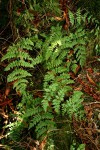Athyrium newtonii Baker
Synonyms |
Athyrium scandicinum (Willd.) C.Presl var. rhodesianum Schelpe |
|---|---|
Common name |
|
Description |
Rhizome erect, 5-8 mm in diameter, sometimes forming a small caudex of 15 × 1.5(4) cm; rhizome scales lanceolate in outline, apex gradually tapering to a point, margin entire, 7-10 x 1-2 mm, pale brown. Fronds monomorphic, tufted, arching, up to 2m tall, herbaceous. Stipe up to 55 cm long, about half as long as the lamina, usually reddish or pinkish when living, straw coloured when dry, glabrous above, sparsely set with scales similar to those on the rhizome towards the base. Lamina 2 to 3-pinnate, basal pinnae slightly or not reduced in size, narrowly ovate-lanceolate in outline, 22-60 cm × 12.5-35 cm; pinnae 9-18 pairs, opposite to alternate, set at 90° to the rhachis, lanceolate in outline, apex shortly tapering to a point; basiscopic pinnules slightly longer throughout the lamina, 1.5-20 x 0.8-8 cm; pinnules 10-20 pairs, bluntly ovate-deltate in outline, about twice as long as broad, glabrous on both surfaces, margin deeply pinnatifid to serrate lobes, with acroscopic lobes more developed; rhachis hairless but with soft spinules up to 1 mm long often present where wings of the rhachis or rhachilla are interrupted by the pinule-bases and some short indumentum sometimes present. Sori up to 1(2) mm long, elongate, curved or J-shaped; indusium brown, subentire. |
Notes | Could be confused with A. schimperi, which is a grassland species with a creeping rhizome and basal pinnae that are obviously reduced. Also resembles A. crassicaule which has a branched rhizome with a series of short, erect caudices. |
Derivation | newtonii: named after Francisco X.O. de A. Newton (1864-1909)who collected the type specimen from West Africa. |
Habitat | Deep shade on wet forest floors and on rocks in streambanks and at waterfalls. |
Distribution worldwide | |
Distribution in Africa |
Burundi, Dem. Republic of Congo, Kenya, Lesotho, Liberia, Malawi, Mozambique, Rwanda, South Africa, Sudan and South Sudan, Swaziland, Tanzania , Uganda, Zimbabwe. |
Growth form |
Lithophytic, terrestrial. |
Literature |
|
